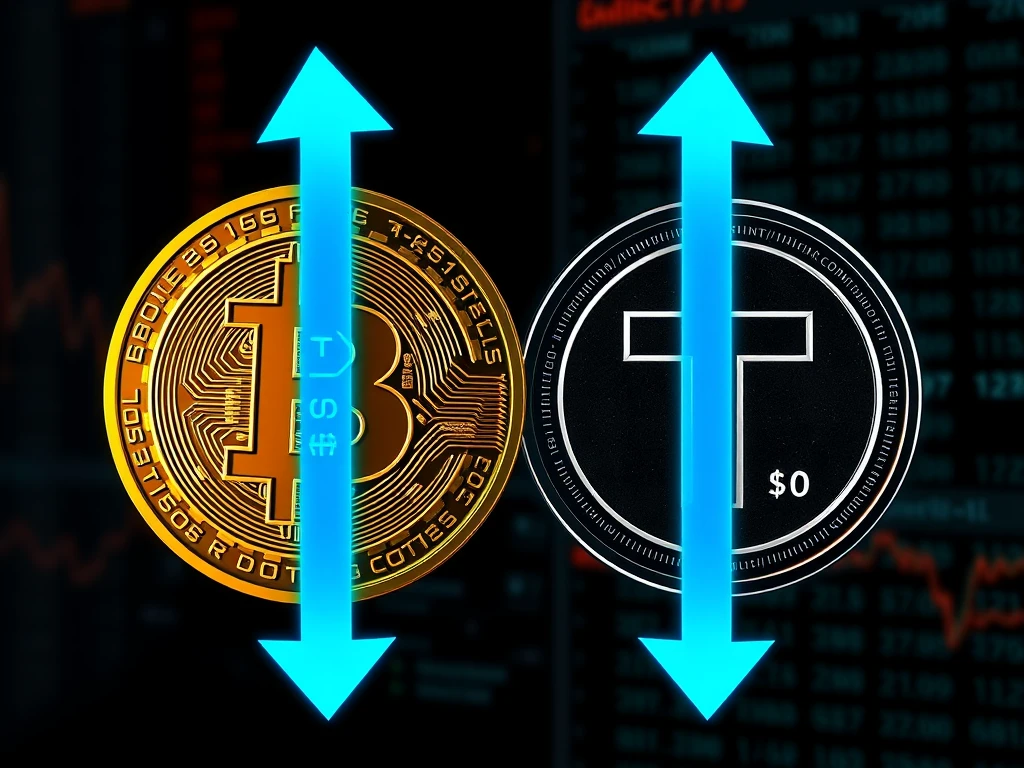Decoding USDT Mints: Unveiling Bitcoin Price Cycle Secrets

Ever wondered if there’s a secret signal hidden within the crypto market’s noise? For years, analysts have speculated about a potential link between Tether’s USDT activities and Bitcoin’s price movements. Now, fresh data is shedding light on this fascinating relationship. Is USDT, the king of stablecoins, still a reliable barometer for Bitcoin price cycles? Let’s dive into the intriguing world of USDT mints and burns to uncover potential clues about market direction.
The Historical Harmony: USDT Mints and Bitcoin Bull Runs
For almost a decade, the supply of Tether’s USDt (USDT) has moved in sync with Bitcoin price cycles. Think of it like this: when Bitcoin gears up for a bull run, USDT mints often surge, and when corrections hit the market, burns tend to follow. Data from Whale Alert visually represents this connection, plotting Tether’s net minting and burning alongside Bitcoin’s price from 2015 to early 2025. This data provides a clearer picture to evaluate the long-debated relationship between USDT supply and BTC performance.
With a massive market capitalization exceeding $144 billion, USDT has become a crucial liquidity tool in the crypto sphere. Many consider it a proxy for broader capital flowing into the crypto markets. Whale Alert’s data underscores how closely USDT issuance patterns align with Bitcoin price cycles, though the cause-and-effect direction is still debated. Large issuances of USDT frequently occur alongside Bitcoin price surges, as visualized in charts from Whale Alert.
Crypto analyst Mads Eberhardt points out that historically, a larger supply of stablecoins, including Tether, has correlated with positive crypto market performance. This is clearly visible in Tether’s mint and burn chart over time. However, he also notes a recent shift. “We have not observed this correlation over the past few months,” Eberhardt explains. “I expect that as stablecoins gain traction in non-crypto use cases, this correlation will gradually weaken.”
USDT Issuance: A Potential Signal for Bitcoin Price Spikes?
Whale Alert’s data reveals a consistent pattern: periods of aggressive USDT minting often coincide with or closely precede major Bitcoin bull runs. This pattern was especially prominent in late 2020 and throughout 2024, when net new USDT issuance ballooned into the tens of billions as Bitcoin’s price skyrocketed.
Consider the late 2024 example: a series of significant USDT mints in October and November accompanied Bitcoin’s impressive climb from $66,700 to over $106,000. Let’s break down this specific rally:
- Oct. 25, 2024: Bitcoin starts a bull run from $66,700.
- Oct. 30, 2024: As Bitcoin hits $72,000, a $1 billion USDT mint occurs after a brief correction.
- Nov. 6, 2024: Following another Bitcoin rally from $65,000 to $75,000, a substantial $6 billion USDT mint is recorded.
- Nov. 6-9, 2024: Bitcoin gains moderately, and Tether mints an additional $6 billion in two batches.
- Nov. 9-18, 2024: A sharp Bitcoin rally to $88,000 follows.
- Nov. 18, 2024: A $6 billion USDT mint marks the beginning of Bitcoin’s next surge.
- Nov. 18-22, 2024: Bitcoin price rallies to nearly $99,000, with Tether issuing another $9 billion in three batches.
- Nov. 23, 2024: A $7 billion USDT mint precedes a brief pullback before Bitcoin’s final surge.
- Dec. 17, 2024: Bitcoin reaches over $106,000.
The timing of USDT mints in late 2024 hints that issuance can be a short-term indicator of growing demand, though not necessarily a pure leading signal. Ki Young Ju, CEO of CryptoQuant, notes that USDT’s role in Bitcoin price cycles might be diminishing over time. “Most new liquidity in the Bitcoin market now comes through MSTR and ETFs, mainly via Coinbase’s BTC/USD market or OTC desks. Stablecoins are no longer a key signal for Bitcoin’s market direction,” Ju explains. He further adds, “In fact, total stablecoins held on exchanges are lower than during the 2021 bull market,” as data from CryptoQuant illustrates.
USDT Burns: Mirroring Bitcoin Corrections?
Conversely, periods of sustained USDT burns, where USDT is removed from circulation, often happen during or shortly after market corrections. This suggests that redemptions tend to follow price dips. This pattern was evident after Bitcoin’s December 2024 peak above $106,000. As Bitcoin declined through January and into March 2025, the chart showed several USDT burns.
Here are some key examples of USDT burns following Bitcoin corrections:
- Dec. 26, 2024: A major $3.67 billion USDT burn occurs after Bitcoin drops from $106,000 to $95,713.
- Dec. 30, 2025: A $2 billion burn follows as Bitcoin declines towards $92,000.
- Jan. 10, 2025: A $2.5 billion USDT mint occurs before Bitcoin rebounds to over $106,000 (Note: This is a mint, but included in the timeline for context).
- Feb. 28, 2025: Another $2 billion USDT burn occurs after a month-long Bitcoin decline from six-digit peaks to around $84,000.
Unlike mints, burns rarely precede downward price movements. Instead, they tend to confirm ongoing corrections, making them useful for tracking post-peak market cooling rather than predicting market tops. This pattern is consistent throughout USDT’s history, including a record $20 billion USDT burn on June 20, 2022, when Bitcoin plummeted from over $65,000 to around $21,000. However, experts like Jos Lazet, founder and CEO of Blockrise, caution against using burns as definitive post-peak signals. “Currently, we have no evidence of a correlation between burns and market tops, nor as a lagging indicator,” Lazet states.
Shifting Stablecoin Landscape: A Game Changer?
While historical data reveals a clear relationship between USDT supply changes and Bitcoin price cycles, it’s crucial to acknowledge other factors influencing Bitcoin’s price. The industry is still searching for definitive proof that USDT issuance directly causes Bitcoin price movements, or if these funds directly flow into Bitcoin.
Jos Lazet explains, “It is not feasible to relate USDT supply (or minting) to a specific trading volume, as most stablecoin trading, especially with Bitcoin, happens on centralized exchanges. While Bitcoin trading volume is largely against USDT, directly correlating these events is likely not feasible.”
The connection between USDT issuance and Bitcoin price action is still debated, but external forces are poised to reshape stablecoin interactions within crypto markets. The Markets in Crypto Assets (MiCA) framework introduces new compliance demands for stablecoin issuers in the European Union. Consequently, several exchanges are delisting USDT. In the US, proposed legislation could also alter how centralized stablecoins like USDT are issued, backed, and redeemed. Increased regulatory scrutiny might limit issuer flexibility or drive a shift towards more compliant alternatives.
Competition is also intensifying. Rivals like USDC, known for its strong compliance, are gaining traction, particularly among institutions. USDC’s market cap faced a dip in 2022-2023 after the Silicon Valley Bank situation but has since rebounded to an all-time high of over $60 billion. Decentralized stablecoins like Dai (DAI) are also appealing to DeFi users who prioritize censorship resistance and on-chain transparency.
The Future of USDT and Bitcoin’s Dance
Tether’s influence on Bitcoin and the broader crypto market remains substantial. However, the question is whether USDT mints and burns will continue to be reliable indicators of capital flow in the years ahead. The answer likely hinges on how regulatory pressures, evolving user preferences, and infrastructure advancements reshape the stablecoin landscape. The relationship between USDT and Bitcoin price cycles is complex and dynamic, and the coming years will be crucial in determining its future trajectory. Keep a close eye on stablecoin developments – they could hold vital clues to the next big moves in the crypto market.









